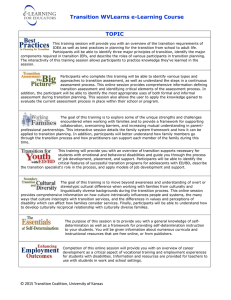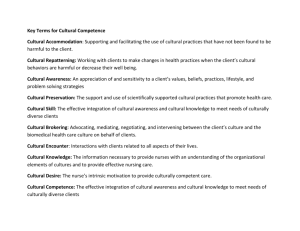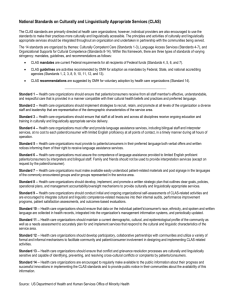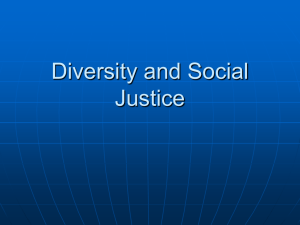Learning Objectives Multi- Cultural Competency : Melvena Wilson, DrPH, MPH, CHES
advertisement
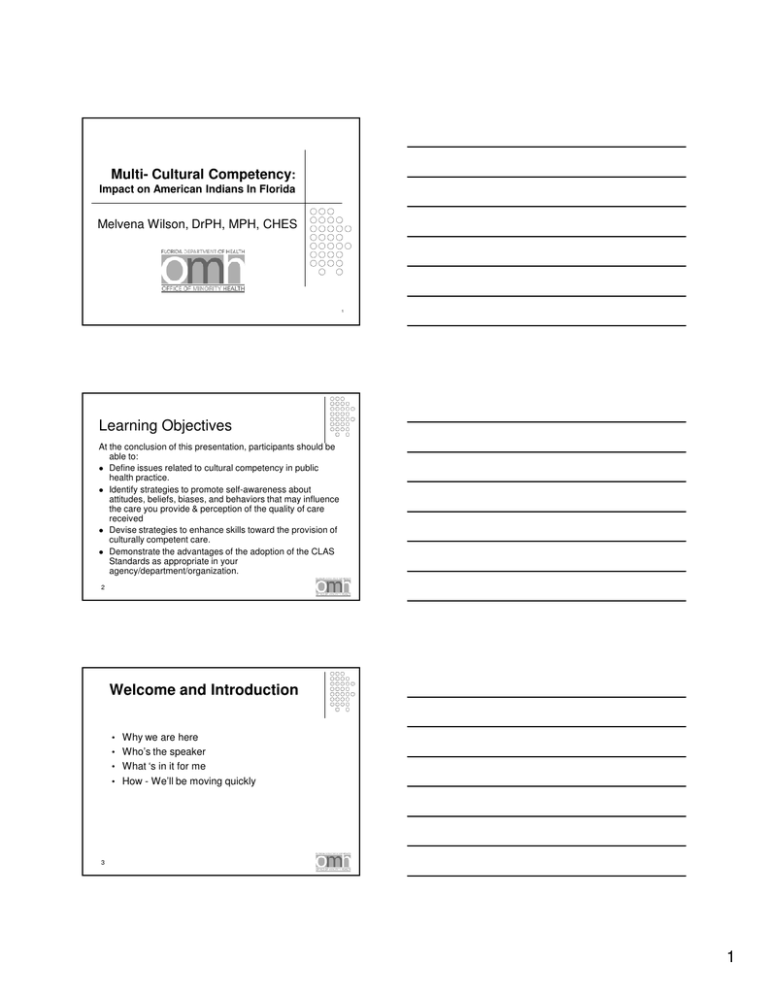
Multi- Cultural Competency: Impact on American Indians In Florida Melvena Wilson, DrPH, MPH, CHES 1 Learning Objectives At the conclusion of this presentation, participants should be able to: Define issues related to cultural competency in public health practice. Identify strategies to promote self-awareness about attitudes, beliefs, biases, and behaviors that may influence the care you provide & perception of the quality of care received Devise strategies to enhance skills toward the provision of culturally competent care. Demonstrate the advantages of the adoption of the CLAS Standards as appropriate in your agency/department/organization. 2 Welcome and Introduction • Why we are here • Who’s the speaker • What ‘s in it for me • How - We’ll be moving quickly 3 1 Training Objectives Provide an overview and opportunity to discuss Cultural and Linguistically Appropriate Services (CLAS) Different ethnic group 4 FLDOH-OMH Overview Poor health outcomes for African Americans, Hispanic Americans, American Indians and Alaska Natives, Asian Americans, Native Hawaiians, and Pacific Islanders are apparent when comparing their health indicators against those of the rest of the U.S. population. These populations experience higher rates of illness and death from health-related conditions such as heart disease, stroke, specific cancers, diabetes, HIV/AIDS, asthma, hepatitis B, and obesity. 5 FLDOH-OMH Overview OMH's primary responsibility is to improve health and healthcare outcomes for racial and ethnic minority communities by developing or advancing policies, programs, and practices that address social, economic, environmental and other factors which impact health. Further, OMH seeks to eliminate health disparities as they relate to groups impacted by disability, gender, age, socio-economic status, mental/behavioral health problems and sexual orientation. OMH is committed to culturally and linguistically competent systems that will ensure the needs of minority communities are integrated and addressed within health-related programs across the state. 6 2 Glossary of Terms CLAS standards – the collective set of culturally and linguistically appropriate services (CLAS) mandates, guidelines, and recommendations issued by the United States Department of Health and Human Services Office of Minority Health intended to inform, guide, and facilitate required and recommended practices related to culturally and linguistically appropriate health services Note: CLAS mandates are current Federal requirements for all recipients of Federal funds (Standards 4, 5, 6, and 7). (National Standards for Culturally and Linguistically Appropriate Services in Health Care Final Report, OMH, 2001). 7 Glossary of Terms cultural and linguistic competence in health - a set of congruent behaviors, attitudes, and policies that come together in a system, agency, or among professionals that enables effective work in cross-cultural situations. culturally and linguistically appropriate services health care services that are respectful of and responsive to cultural and linguistic needs ( 8 What is Culture Culture is an essential mediator in people's health status, Culture crosses age, gender, religion & ethnicity Includes our language, customs, beliefs &values Other factors including health status environment, economics, genetics, previous and current health status, and psycho-social factors exert considerable influence on our well-being. These are the social determinants of health 9 3 Cultural Competency ~ What is that? Cultural and linguistic competence is a set of congruent behaviors, attitudes, and policies that come together in a system, agency, or among professionals that enables effective work in cross-cultural situations. 'Competence' implies having the capacity to function effectively as an individual and an organization within the context of the cultural beliefs, behaviors, and needs presented by consumers and their communities. (Adapted from Cross, 1989). 10 Cultural Competency ~ What is that? Cultural competency is central to closing the disparities gap in health care. It’s the way patients and doctors can come together and talk about health concerns without cultural differences hindering the conversation, but enhancing it. Health care services that are respectful of and responsive to the health beliefs, practices and cultural and linguistic needs of diverse patients can help bring about positive health outcomes. 11 Culture and language may influence: health, healing, and wellness belief systems; how illness, disease, and their causes are perceived; the behaviors of patients/consumers who are seeking health care and their attitudes toward health care providers; the delivery of services by the provider who looks at the world through his or her own limited set of values, 12 4 What is CLAS? The CLAS standards are primarily directed at health care organizations; however, individual providers are also encouraged to use the standards to make their practices more culturally and linguistically accessible. The principles and activities of culturally and linguistically appropriate services should be integrated throughout an organization and undertaken in partnership with the communities being served. The 14 standards are organized by themes: Culturally Competent Care (Standards 1-3), Language Access Services (Standards 4-7), and Organizational Supports for Cultural Competence (Standards 8-14). Within this framework, there are three types of standards of varying stringency: mandates, guidelines, and recommendations as follows: CLAS mandates are current Federal requirements for all recipients of Federal funds (Standards 4, 5, 6, and 7). 13 Did You Know . . . Providers can influence the level, quantity and quantity of diagnostic care given Patients may be non-compliant for several reasons Just being of the same ethnicity as your clients doesn’t automatically make you competent Mental Health issues can manifest themselves with physical symptoms 14 I’ve had training…. What's the Difference? Cultural competence emphasizes the idea of effectively operating in different cultural contexts, and altering practices to reach different cultural groups. Cultural knowledge, sensitivity, and awareness do not include this concept. Although they imply understanding of cultural similarities and differences, they do not include action or structural change. Cultural Competence, Awareness, and Sensitivity 15 5 The Difference is… Cultural Awareness: Developing sensitivity and understanding of diverse groups involving internal changes in terms of attitudes and values. Cultural Knowledge: Familiarization with cultural characteristics, history, values, belief systems, and behaviors of another ethnic group. Cultural Skill: A skill set to access an individual’s background and formulate a culturally relevant treatment plan. Cultural Sensitivity: Knowing cultural differences and similarities exist, without assigning them values, ie., better or worse, right or wrong. Interpretation: Facilitating oral communication between individuals who do not speak the same language and may not share the same culture. 16 How can we incorporate this into our services Adapting to different cultural beliefs and practices requires flexibility and a respect for others view points. Cultural competence means to really listen to the patient, to find out and learn about the patient's beliefs of health and illness. To provide culturally appropriate care we need to know and to understand culturally influenced health behaviors. 17 Application Why Culturally Competent Care? Have you ever experienced a situation where you were unsure about the best way to approach a someone (a classmate, teacher, coworker) because of racial or ethnic concerns? Was there ever a time when language differences prevented you from effectively communicating with a patient? Have you ever stopped to wonder if you were understood 18 6 Implications Why Culturally Competent Care? Increasingly diverse racial, ethnic, and socio-cultural backgrounds of patients, colleagues, and staff may present challenges to you as you strive to provide care. Cultural and language differences may engender misunderstanding, a lack of compliance, or other factors that negatively influence clinical situations and impact patient health outcomes. 19 Discussion/Activity Cultural Differences in body language and expressions Sharing of personal information Work ethic differences across generations Miscommunication or Misperceptions Can be the result of Cultural differences 20 Discussion/Activity Young mother walks into clinic/office with 5 crying children…. What is your first thoughts/reactions? Write them down Now what is your experience with a client like this WHY do you feel this way? 21 7 Discussion/Activity Couple walks into your office/clinic neither speaks English well, but he speaks broken/limited English What is your first thoughts/reactions? Write them down Now what is your experience with a client like this WHY do you feel this way? 22 Discussion/Activity What is your first thoughts/reactions? Write them down Now what is your experience with a client like this WHY do you feel this way? 23 Discussion/Activity Man walks into your office/clinic he is dressed in torn, dirty clothes, and doesn’t make eye contact What is your first thoughts/reactions? Write them down Now what is your experience with a client like this WHY do you feel this way? 24 8 Accommodations It’s about respect: ADA LEP Interpreters Translators Health literacy (beyond reading level) Areas of Concern Communicating Across Cultures in a Clinical Setting Understanding Patients' Customs and Beliefs Client Services for Limited English Proficiency Cultural Sensitivity for Client Services Generations at Work: Differing Styles and Expectations Building Diverse Teams Understanding Diversity 26 African Americans Black includes populations from Caribbean ( Jamica, Haiti, etc.) History in america of forced migration or slavery ~ Racism Distrust – Tuskegee Study (1932-1972) Natural illness (God’s Will) Dietary habits 9 Hispanic Hispanic (hispano) – literally means “from Spain” Latin- includes everyone from Latin America Different dialects Origin of birth matters 57% Catholic – use of word sex Hot and cold properties Folk healers Asian American Many Countries (China, Japan, Thai, India, etc.) Country of origin matters Many dialects CAM vs Medical model of healing and causation Fastest group- increase in FL American Indian Descends of “the original peoples” of North and South America Many nations or tribes (over 561 federally recognized) Proud and self-determined Tribal sovernity (self government) Harmony with nature (Supreme creator) 10 Religion Restrictions on holy days and certain time sof the day Dietary restrictions (food prep and type) Mediation and certain procedures Benefits of prayer and meditation Birthing rituals End of life decisions Body prep; organ donation; burial Religion/Spirtuality Don’t assume Catholic = birth control Muslim/Islamic = female purity (male doctors) Jewish = dietary restrictions Seventh Day Advent = restrictions on a specfic day of the week; blood products Other considerations Sexuality Homopathic alternatives Use of ethnic remedies 11 What’s the next steps? Understand language access laws, and national standards on culturally and linguistically appropriate services (CLAS) for bilingual staff and community interpreters Understand interpreting roles and types and modes of interpreting Develop interpreting skills in pre-session preparation, introductions, tone, positioning, register, halting the session, note-taking, and memory 34 What’s the next steps? Understand cultural competence and cultural constructs, and how and mediate culturally Respect a code of ethics, have clear roles and boundaries, and maintain accuracy and confidentiality Understand interpreting in health care, educational and/or human services settings (training will be specialized to address the audience’s needs) 35 Resources CDC NPIN http://www.cdcnpin.org/scripts/population/cult ure.asp HRSA Care Action: Mitigating Health Disparities Through Cultural Competence National OMH NOTE: Information presented in this presentation has been compiled from and adapted from the above websites and resources. 36 12 Contact Information Dr. Melvena Wilson, DOH Office of Minority Health Melvena_Wilson@doh.state.fl.us 850-245-4941 37 37 Culturally Competent Guiding Values & Principles Practice & Service Design Cultural competence is achieved by identifying and understanding the needs and help-seeking behaviors of individuals and families.* Culturally competent organizations design and implement services that are tailored or matched to the unique needs of individuals, children, families, organizations and communities served.* Practice is driven in service delivery systems by client preferred choices, not by culturally blind or culturally free interventions.* Culturally competent organizations have a service delivery model that recognizes mental health as an integral and inseparable aspect of primary health care. 38 Culturally Competent Guiding Values & Principles Organizational Systems and organizations must sanction, and in some cases mandate the incorporation of cultural knowledge into policy making, infrastructure and practice.* Cultural competence embraces the principles of equal access and non-discriminatory practices in service delivery.* 39 13 Culturally Competent Guiding Values & Principles Community Engagement Cultural competence involves working in conjunction with natural, informal support and helping networks within culturally diverse communities Communities determine their own needs. Community members are full partners in decision making. Communities should economically benefit from collaboration. Community engagement should result in the reciprocal transfer of knowledge and skills among all collaborators and partners. 40 Culturally Competent Guiding Values & Principles Family & Consumers Family is defined differently by different cultures. Family as defined by each culture is usually the primary system of support and preferred intervention. Family/consumers are the ultimate decision makers for services and supports for their children and/or themselves. 41 Guiding Values and Principles for Language Access Services and supports are delivered in the preferred language and/or mode of delivery of the population served. Written materials are translated, adapted, and/or provided in alternative formats based on the needs and preferences of the populations served. Interpretation and translation services comply with all relevant Federal, state, and local mandates governing language access. Consumers are engaged in evaluation of language access and other communication services to ensure for quality and satisfaction. 42 14
